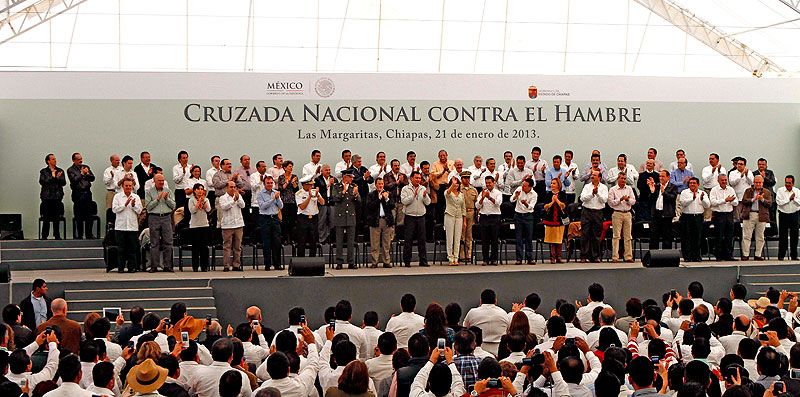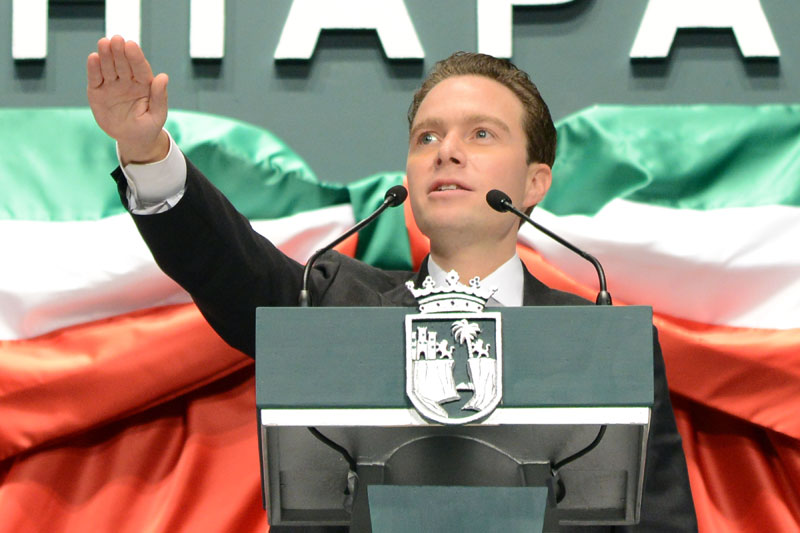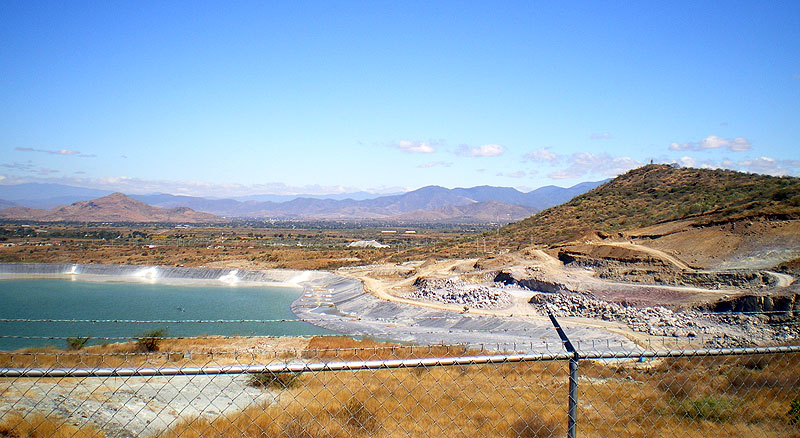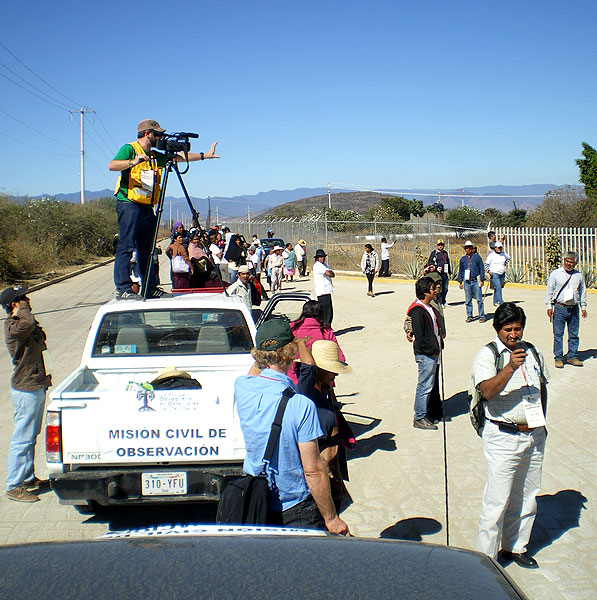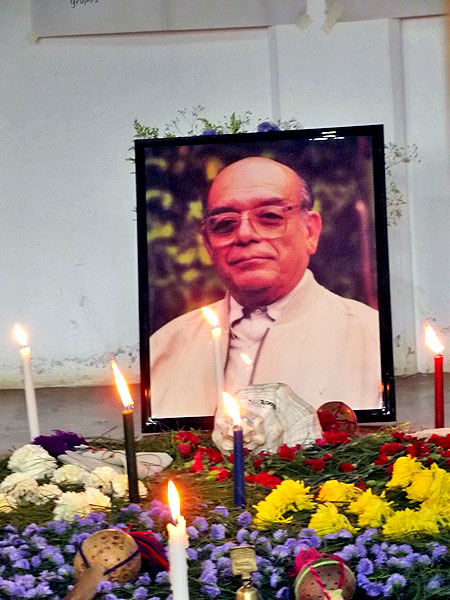
2012
07/02/2013
IN FOCUS: The Tila ejido, an example of struggle for land and territory
24/02/2013As was foreseen, between October and December—though with some difficulties and tensions—in Chiapas the new governor, municipal mayors, and part of the new Congress came into power, thus coinciding with the change of presidency of the Republic.
More surprisingly, on 21 December (a symbolic day in terms of the change in Baktún, the beginning of the new Mayan era), tens of thousands of indigenous support-bases of the Zapatista Army of National Liberation (EZLN) marched in 5 cities of the state. Contingents of between 5000 to 15000 base supporters were observed in each place. The communiqué released subsequently by the Zapatista General Command made reference to the rigorous silence maintained throughout the day and brought to attention the unspoken message “Have you heard? It is the sound of their world collapsing. It is the sounds of our world resurging.”
The return of the PRI to the presidency
On 1 December, Enrique Peña Nieto, candidate of the Institutional Revolutionary Party (PRI) and the Green Ecological Party of Mexico (PVEM), took power as president of the Republic. During the day a number of different protests broke out which came to an end following seven hours of disturbances, resulting in 105 injured (29 of whom required hospitalization) and dozens of arrests. For his part, Andrés Manuel López Obrador, presidential candidate of the center-left, refused to recognize the new president, opting instead for the construction of a new party based on the Movement for National Regeneration (MORENA), which was very active during the electoral process. From another perspective, the principal party leaders signed a “Pact for Mexico” just days after Peña Nieto’s inauguration, one that defines strategic lines to continue. The initiative has been challenged for having excluded social participation, and it could be considered a return to the old forms of the PRI’s political maneuvering.
In the first acts of the new government (a move that was seen as a means to gain legitimacy), Peña Nieto decided to suspend the controversy imposed by former president Felipe Calderón against the General Law on Victims—this being a motion that could have prevented its being signed into law. Consequently, the General Law entered legislation in February.
In more general terms, a large part of the beginning of this new six-year term has centered around a broad structural reform of the public administration: in January, the Secretary for Public Security was abolished, having been integrated into the Secretary of Governance. This centralization could imply an advantage in the sense of national security from the perspective of the State apparatus, but it could also mean a major risk in terms of human rights. Amnesty International recalls that “during the six-year term of former president Felipe Calderón, the SSP took on a protagonistic role in the strategy against organized crime, one that has left more than 60,000 dead and thousands others disappeared. The use of torture and abuse as well as arbitrary arrests were routine on the part of the security forces during that period.” Peña Nieto has proposed the creation of a “national gendarmerie,” a sort of militarized police, which would not signify substantial change, given that the war against organized crime undertaken in the previous administration has blurred the line separating the constitutional distinction between police and the military. There has also been seen an attempt to create a National Center for Intelligence (CNI), a sort of Mexican CIA that would centralize the information collected by all security and justice institutions. Meanwhile, the number of casualties linked to narco-violence and the war against it continue without respite. According to the Secretary of Governance, 2,243 murders were reported during the first two months of the new administration.
Inauguration of Manuel Velasco Coello as governor
On 8 December, Manuel Velasco Coello became governor of Chiapas. He won the elections last July with a large margin, representing the coalition of the Green Ecological Party (PVEM), PRI, and New Alliance (PANAL). He announced that he would present a state plan of austerity, reducing salaries and spending by the government.
Upon taking power, he also announced that he would establish a government of citizen coalition, one that would be plural and inclusive, although to date he has made few nominations and continues actually to operate largely with the cabinet of the former governor. In mid-December, regardless, human-rights organizations released a communiqué regarding the naming of Jorge Luis Llaven Abarca as Secretary of Public Security in Chiapas, indicating him to be a “perpetrator of acts of arbitrary detentions, disproportionate and undue use of public force, criminal preventive detentions (“arraigo”), death threats, torture, and other human-rights violations.”
Lights shined onto the shadows of the Sabines government
Speaking to the state Congress shortly before the end of Juan Sabines Guerrero’s term as state governor, Noé Castañón, his secretary of governance, noted that “Among the legacies of greatest significance and transcendence that remain for Chiapas and its citizens, for the government that is ending and the one to follow it is respectively to leave a state of peace, with security and harmony, and to receive such.” It is likely that few people in Chiapas will share this perception, some months after the transition has progressed, given the debts and state of disarray in which the public administration was left. In several cities there have been multitudes of people marching to demand justice and a balancing of accounts, as well as protesting against the charges for vehicular driving licenses that have been implemented to diminish the state’s financial crisis. According to official accounts, the state’s debt is greater than 20 billion pesos, but several journalistic sources affirm that it could reach 40 billion. Some of the sources add that these resources were earmarked for the operation of non-existent firms. In parallel terms, 70 of 122 municipalities of Chiapas have declared themselves bankrupt, and numerous former mayors find themselves imprisoned or under investigation. Regarding the ex-governor, the local Congress in May 2011 conveniently carried out reforms that impede that Sabines Guerrero be held accountable in any administrative or penal investigation regarding his time in office.
Furthermore, there have begun to be seen several other challenges regarding not only the management of public finances but also regarding other aspects of the former administration. Deputy Alejandra Soriano Ruiz (PRD) has denounced the persecution of 200 social and campesino leaders, members of oppositional parties, trade-unionists, and human-rights defenders. In other news, in November, the Table for Transborder Coordination of Migration and Gender (MTMG) presented its report “Abyss between the word expressed and exercised action: the migratory policy of the government of Juan Sabines Guerrero” – a title that emphasizes the evident gap between official discourses and that which really took place during the previous administration.
Repositioning of the EZLN and initial governmental reactions
The massive marches undertaken by the EZLN in December succeeded in “creating” a new “context” (see the Zapatista communiqué of February). Furthermore, a day before rumors of a possible mobilization, the state government released 4 prisoners, 2 of them being Zapatista base supporters to “contribute to a reduction in tensions” and the strengthening of a climate “of tolerance and peace” in the state. In this sense, the state government also proposed “the convenience of a minimal mechanism” of communication with the Zapatista Good-Government Councils that would permit the prevention and resolution of any conflicts that could arise.
Subsequently, on different occasions, both the federal government and the state government of Chiapas expressed themselves in regard to the Zapatista mobilization. Miguel Ángel Osorio Chong, secretary of governance, declared that “they still do not know us; we hope they do not come out too soon, given that President Enrique Peña Nieto has a great commitment to the indigenous peoples.”
On 30 December, the EZLN released a communiqué and two letters. In these documents, it strongly criticizes the different political parties, the federal government (both the present one and the previous one), and the state and municipal governments. It affirmed that all have failed in their attempts to weaken indigenous resistance.
On 1 January, governor Manuel Velasco made a call for the observance of the San Andrés accords on indigenous rights and culture, signed between the EZLN and the federal government in 1996. The governor announced a series of actions by the government regarding concrete conflicts and in regard to the demand for the release of Alberto Patishtán Gómez and Francisco Santiz López. Beyond this, the governor announced his position regarding two questions having to do with local community conflict, noting on the one hand that “We will respect the possessions of Zapatista lands that now are being used with social benefit.” Beyond this, he assured that “all state development programs in communities with Zapatista presence will be careful in their propositions and implementation. It is not our aim to divide communities.” While the governor addressed critical issues, the resolution of several of these questions is out of his hands, depending instead on the federal government. Apropos, on 25 January was released Francisco Sántiz López, a Zapatista base supporter who had been imprisoned since 2011.
In January, after publishing an “illustrated letter” directed to his “critics,” there was released a series of postscripts in which Subcomandante Marcos indicated that for many the EZLN does not exist, if it does not appear publicly. After this, a series of communiques began to be released signed by Marcos and then in February by Subcomandante Moisés. It should be mentioned that this communiqué was released just hours before President Enrique Peña Nieto arrived in Chiapas to launch the National Crusade against Hunger in the Las Margaritas municipality. Notably, Las Margaritas is one of the poorest municipalities in the country and it is considered to be a Zapatista bastion. The next day, Marcos published yet another illustrated letter which casts Peña Nieto’s visit and his “Crusade” in a sardonic light.
Although the EZLN was not directly mentioned, at least one other decision taken by the federal government has been challenged for its potentially counter-insurgent purposes. On 14 January, the Secretary of Governance announced the decision to transform the Commission for Dialogue and Negociation in Chiapas into the Commission for Dialogue with Indigenous Peoples. The Secretary noted that with this move it is sought to evaluate the debt owed to indigenous peoples, by means of a permanent policy of dialogue to guarantee all peoples access to justice, education, health-care, and infrastructure. Nevertheless, the move seeks to displace the EZLN from center stage.
If these communiques which have continued to be published reflect that the EZLN has defined several actions regarding what it plans to do, and with whom, they do not reveal the totality of what it has planned at the moment of the publication of this bulletin.
In other news, numerous sit-ins, marches, pilgrimages, meeting, and communiqués were carried out by different civil and social organizations throughout the state in recent months. In January, the Believing People, an organizational process associated with the diocese of San Cristóbal de Las Casas, carried out a pilgrimage in this city. The pilgrimage of some 10,000 people demonstrated their concern regarding “the launching of the National Crusade against Hunger, precisely in the municipality of Las Margaritas, given that with this action the federal government’s strategy of not attending to the structural necessities of the people is shown clearly.” In their message, the Catholics equally denounced “the concessions for mineral exploitation that the federal government has awarded, particularly to foreign firms, thus totally violating the peoples’ fundamental right to prior informed consent,” among other demands.
In January, the Las Abejas Civil Society challenged the National Crusade against Hunger as being nothing more than a “pretty painting.” “[S]/he who lives from the welfare of the State is a slave. We are clear that their projects will not benefit us: they merely change the laws so that indigenous peoples remain ignorant.” Another of the points it locates as being part of this “pretty picture” is the new interest that has been expressed by authorities with regard to the San Andrés accords regarding indigenous rights and culture. The Society questions whether its observance will in fact come to pass.
Guerrero: emergence of self-defense processes in light of ongoing violence
Given the inefficacy of the authorities amidst the extortion, disappearances, rapes, robbery, and murders committed by organized crime, there have emerged in Guerrero self-defense processes that have generated strong national media coverage, followed by similar initiatives elsewhere in the country. On 6 January, four municipalities of the Costa Chica decided to take up arms to directly confront organized crime. Checkpoints were installed and 54 persons arrested for supposed offenses related to organized crime. On 31 January, in Ayutla de Los Libres, the first session of a “popular tribunal” was also held during which the accused were presented.
In light of these acts, governor Ángel Aguirre Rivero installed the Commission for Harmony of Indigenous Peoples in Guerrero at the beginning of February, so as to analyze “the handing over of the arrested who find themselves in Ayutla […] who should be subjected to the established laws and institutions.” Organizations committed to the defense of human rights have warned that with the emergence of these self-defense groups as well as the creation of this Commission –that according to them, lacks legitimacy – is provoking a greater move towards militarization in indigenous communities.
The self-defense processes of the peoples of the Costa Chica are being led by the Union of Peoples and Organisms of the State of Guerrero (UPOEG). The Regional Coordination of Communal Authorities-Communal Police (CRAC-PC), which has worked for 17 years in the same zone and several others in the state, has repeatedly distanced itself from these processes. The CRAC-PC has also rejected the state decree that seeks to regulate and institutionalize the communal police. The differences between the two processes are threatening the system of communal justice in its totality, although at the close of this report, there were attempts to seek forms of agreement between the two. Whether they succeed in this is a delicate matter: the National Commission on Human Rights (CNDH) has affirmed that the self-defense groups in the states of Guerrero, Oaxaca, and Michoacán affect state stability and are a problem of national security.
Meanwhile, violence continues to grip several parts of the state. In November, Juventina Villa Mojica, director of the Organization of Ecologist Campesinos of the Sierra de Petatlán and Coyuca de Catalán (OCESP), denounced the murder of two of her nephews. Just two weeks later, she was murdered together with her 10 year-old son during an ambush, despite the fact that they had been protected by at least 25 police agents who had been assigned to ensuring their security since May 2012. 45 families from her community of origin, La Laguna, fled to Puerto de las Ollas in response.
Beyond this, attacks on rights-defenders and attempts to devalue their work have not diminished. In February for example, the Guerrero Truth Commission (Comverdad Guerrero), which investigates human-rights violations committed during the so-called “Dirty War” of the 1960s and 1970s, denounced that one of its investigators and the son of one of the disappeared whose whereabouts comprises part of the investigation were subjected to anonymous death-threats and harassment.
Oaxaca: extraction and energy projects behind increases in communal conflict
Tensions have been particularly high in some of the communities of the Tehuantepec Isthmus, where a struggle has been undertaken against the wind-energy project advanced by the Mareña Renewables firm. On 29 December in San Dionisio del Mar, opponents and proponents of the project engaged in a confrontation over the realization of an assembly to which the opposing group was denied access. The confrontation left 12 persons injured. Subsequently, two attempts were made to organize an assembly to grant support to the wind-energy project, though without success to date. Several civil and social organizations have condemned the “intimidating actions and the campaign of harassment promoted by the firm Mareña Renewables,” several governmental officials, and media against the opponents.
In November, in another of the symbolic struggles for land and territory in the state, an observation mission arrived to the community of San José del Progreso, Oaxaca Its announced purpose was ro work toward the goal of making visible the human-rights violations committed against members of the Coordination of the United Peoples of the Ocotlán Valley (CPUVO), who have resisted the activities of the Cuzcatlán mining firm, which is a subsidiary of the Canadian corporation Fortune Silver Mines. The civil observation mission declared in a press-conference that it had observed the systematic violation of human rights in the region, together with a climate of insecurity, fear, and strong division as follows from mining operations. The mission affirmed that the project had been imposed without the consultation of the local population, and it denounced the harassment directed against opponents of the mine, as well as the existence of a strong relationship between the mining company and municipal authorities.
More broadly, Oaxaca is the state with the largest number of cases of abuse against human-rights defenders in the entire country. According to Services for an Alternative Education (EDUCA), from January to November 2012, 120 acts of violence against human-rights defenders had been seen in the state. In December, moreover, several organizations presented the “Special Report on Violence and Impunity against Female Activists and Human-Rights Defenders in Oaxaca,” which documents 48 aggressions against 30 female defenders in the state in 2012. These organizations declared at their press conference that “Intimidation and harassment have become daily attacks, while death threats, injuries, arbitrary detentions, and campaigns of slander and defamation have become more common.”


